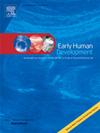Predictive model of neurodevelopmental outcome in neonatal hypoxic ischemic encephalopathy
IF 2
3区 医学
Q2 OBSTETRICS & GYNECOLOGY
引用次数: 0
Abstract
Objectives
To build an early, prognostic model for adverse outcome in infants with hypoxic ischemic encephalopathy (HIE) receiving therapeutic hypothermia (TH) based on brain magnetic resonance images (MRI), electrophysiological tests and clinical assessments were performed during the first 5 days of life.
Methods
Retrospective study of 182 neonates with HIE and managed with TH. The predominant pattern of HIE brain injury on MRI performed following cooling was scored by neuroradiologists. The electroencephalogram (EEG) background and evoked potential (EP) response, were analyzed. Area under the curve (AUC) of these tools for adverse outcome including death and/or moderate disabilities using the Bayley-III at 36 months were calculated. A stepwise model approach was used to reach the final most efficient predictive model.
Results
Of 182 neonates, 99 were male (54.4 %), with median gestational age of 39 weeks (IQR 38–40) and median weight of 3.3 kg (IQR 2.9–3.7). On admission, 47 (26 %), 104 (57 %) and 31(17 %) neonates presented with mild, moderate and severe encephalopathy respectively. In multivariate analysis of 129 infants who received all prognostic modalities, the predictive value of a model of EEG plus MRI, AUC = 84 %) is equivalent to models of EEG plus MRI with added EP and clinical assessment at discharge (AUC = 84 and 85 % respectively).
Conclusion
In the era of cooling for neonatal HIE, the combination of EEG background and MRI during the first few days of life, provide an objective and highly reliable model for prediction of death and long-term disabilities.
新生儿缺氧缺血性脑病神经发育结局的预测模型。
目的:基于脑磁共振成像(MRI)、电生理测试和临床评估,建立缺氧缺血性脑病(HIE)婴儿接受治疗性低温治疗(TH)不良结局的早期预后模型。方法:对182例HIE患儿进行回顾性研究。冷却后MRI上HIE脑损伤的主要模式由神经放射学家评分。分析脑电图(EEG)背景和诱发电位(EP)反应。使用Bayley-III计算36个月时这些工具对不良结果(包括死亡和/或中度残疾)的曲线下面积(AUC)。采用逐步建模方法,得到最终最有效的预测模型。结果:182例新生儿中,男性99例(54.4%),中位胎龄39周(IQR 38-40),中位体重3.3 kg (IQR 2.9-3.7)。入院时,分别有47例(26%)、104例(57%)和31例(17%)新生儿表现为轻度、中度和重度脑病。在对129名接受所有预后方式的婴儿进行的多变量分析中,EEG + MRI模型的预测价值(AUC = 84%)与EEG + MRI模型加上EP和出院时临床评估的预测价值(AUC分别= 84%和85%)相当。结论:在新生儿HIE降温时代,新生儿出生后数天脑电图背景与MRI相结合,为预测死亡和长期残疾提供了客观、高可靠性的模型。
本文章由计算机程序翻译,如有差异,请以英文原文为准。
求助全文
约1分钟内获得全文
求助全文
来源期刊

Early human development
医学-妇产科学
CiteScore
4.40
自引率
4.00%
发文量
100
审稿时长
46 days
期刊介绍:
Established as an authoritative, highly cited voice on early human development, Early Human Development provides a unique opportunity for researchers and clinicians to bridge the communication gap between disciplines. Creating a forum for the productive exchange of ideas concerning early human growth and development, the journal publishes original research and clinical papers with particular emphasis on the continuum between fetal life and the perinatal period; aspects of postnatal growth influenced by early events; and the safeguarding of the quality of human survival.
The first comprehensive and interdisciplinary journal in this area of growing importance, Early Human Development offers pertinent contributions to the following subject areas:
Fetology; perinatology; pediatrics; growth and development; obstetrics; reproduction and fertility; epidemiology; behavioural sciences; nutrition and metabolism; teratology; neurology; brain biology; developmental psychology and screening.
 求助内容:
求助内容: 应助结果提醒方式:
应助结果提醒方式:


